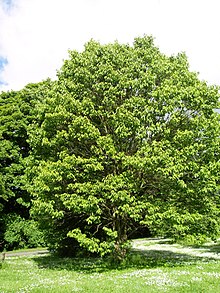Hovenia dulcis
| Hovenia dulcis | |
|---|---|

| |
| Scientific classification | |
| Kingdom: | |
| (unranked): | |
| (unranked): | |
| (unranked): | |
| Order: | |
| Family: | |
| Genus: | Thunb.
|
| Species: | H. dulcis
|
| Binomial name | |
| Hovenia dulcis | |
Hovenia dulcis is also called the oriental raisin tree. It is a plant that lives in Japan, Korea, Eastern China and the Himalayas.
Life cycle[change | change source]
The oriental raisin tree grows about 10 meters tall. Its bark of the tree is dark gray. Its flowers are white, and they open between June and July. The tree grows fruit in September and October. The fruits are brown, and they are shaped like a chicken's claw. Its seeds fall off from February to March. Its germination rate, which is the number of seeds that begin to spore or grow, is about 2 – 15%. Most trees begin to grow their own fruit when they are two years old.
Living conditions[change | change source]
The oriental raisin tree can grow with shade or light. Cold does not hurt the tree, but too much time without rain does hurt it. Unlike many other plants, the oriental raisin tree can grow even if the soil has lots of salt in it, so often lives near the sea. Pollution does not hurt the oriental raisin tree either, so it can live in cities and other industrial areas.
Uses and effects[change | change source]
The wood of the oriental raisin tree can be used to make buildings, musical instruments, ships, and furniture. Because the stem tastes sweet, people like to eat it and make drinks from it. This stem is also used for medicine.
